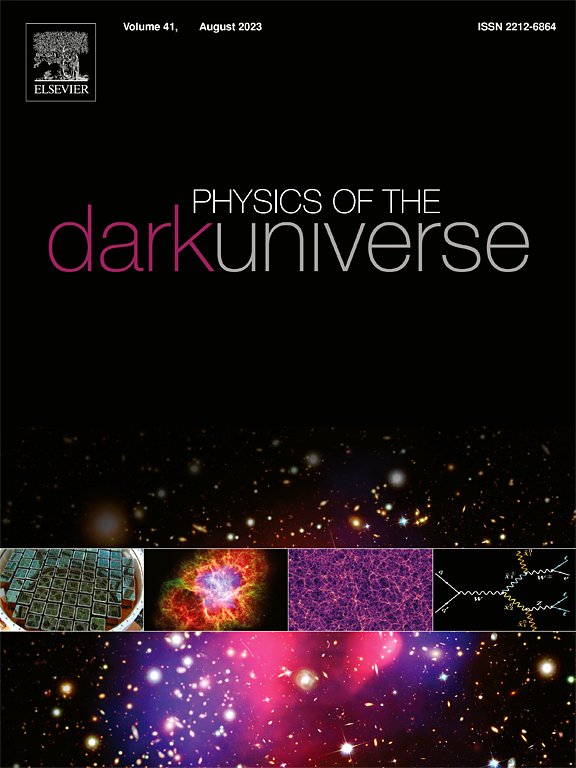Testing linear non-minimal coupling in f(Q,T) gravity using X-ray binary pulsars constrained by NICER observations
IF 6.4
2区 物理与天体物理
Q1 ASTRONOMY & ASTROPHYSICS
引用次数: 0
Abstract
X-ray binary pulsars are valuable for testing alternative gravity theories like gravity because they host neutron stars (NSs) with strong gravitational fields and measurable matter interactions. The linear non-minimal coupling between and can affect the star’s structure and emission, which Neutron Star Interior Composition Explorer (NICER) can constrain through high-precision X-ray timing and spectral data. In this work, we explore the physical implications of such couplings within the gravity framework, focusing on realistic, anisotropic stellar configurations. Using analytical methods, we model spherically symmetric NSs and calibrate our approach against well-observed pulsars including Her X-1, 4U 1538-52, and SMC X-1. The resulting configurations satisfy essential physical requirements: positive, finite energy density and pressure profiles; regularity at the center; vanishing radial pressure at the surface; and stable, causal behavior throughout. Pressure anisotropy remains positive, contributing to hydrostatic balance via a repulsive force that opposes gravity. The radial and tangential sound speeds remain subluminal, and the adiabatic index exceeds across the star, increasing outward—indicating resistance to collapse under perturbations. The relations predicted by the model align well with observations. For example, with , we find and km; increasing to 1.0 gives and km. Similarly, for , we obtain and km, while increasing to 0.8 yields and km. These trends highlight the role of and in controlling stellar compactness and stiffness. The model naturally captures a broad range of NS configurations, without relying on a fixed equation of state (EOS), and remains consistent with nuclear saturation density constraints. Altogether, these results establish gravity as a physically robust and observationally viable extension of general relativity (GR)—one capable of capturing the internal dynamics of compact stars with precision.
利用NICER观测约束的x射线双脉冲星测试f(Q,T)重力中的线性非极小耦合
x射线双星脉冲星对于测试f(Q,T)引力等替代引力理论很有价值,因为它们拥有具有强引力场和可测量物质相互作用的中子星(NSs)。Q和T之间的线性非极小耦合会影响恒星的结构和发射,中子星内部成分探测器(NICER)可以通过高精度的x射线时序和光谱数据来约束这一耦合。在这项工作中,我们探讨了f(Q,T)=χ1Q+χ2T重力框架内这种耦合的物理含义,重点关注现实的各向异性恒星配置。利用分析方法,我们建立了球对称NSs模型,并针对包括Her X-1、4U 1538-52和SMC X-1在内的观测良好的脉冲星校准了我们的方法。由此产生的配置满足基本的物理要求:正的、有限的能量密度和压力分布;中心有规律性;表面径向压力消失;以及稳定的因果行为。压力各向异性仍然为正,通过与重力相反的排斥力有助于流体静力平衡。径向和切向声速仍然低于光速,绝热指数Γ在整个恒星上超过4/3,向外增加,表明在扰动下抵抗坍缩。模型预测的M - R关系与观测值吻合得很好。例如,χ1=0.8时,M≈0.95,M⊙,R≈9.18 km;将χ1增大到1.0,M≈1.19,M⊙,R≈11.39 km。同样,对于χ2=0.0,我们得到M≈1.21,M⊙,R≈11.61 km,而将χ2增大到0.8,我们得到M≈1.19,M⊙,R≈11.38 km。这些趋势突出了χ1和χ2在控制恒星致密度和刚度方面的作用。该模型自然地捕获了广泛的NS配置,而不依赖于固定的状态方程(EOS),并且与核饱和密度约束保持一致。总之,这些结果确立了f(Q,T)引力作为广义相对论(GR)的物理上可靠和观测上可行的延伸,能够精确地捕捉致密恒星的内部动力学。
本文章由计算机程序翻译,如有差异,请以英文原文为准。
求助全文
约1分钟内获得全文
求助全文
来源期刊

Physics of the Dark Universe
ASTRONOMY & ASTROPHYSICS-
CiteScore
9.60
自引率
7.30%
发文量
118
审稿时长
61 days
期刊介绍:
Physics of the Dark Universe is an innovative online-only journal that offers rapid publication of peer-reviewed, original research articles considered of high scientific impact.
The journal is focused on the understanding of Dark Matter, Dark Energy, Early Universe, gravitational waves and neutrinos, covering all theoretical, experimental and phenomenological aspects.
 求助内容:
求助内容: 应助结果提醒方式:
应助结果提醒方式:


